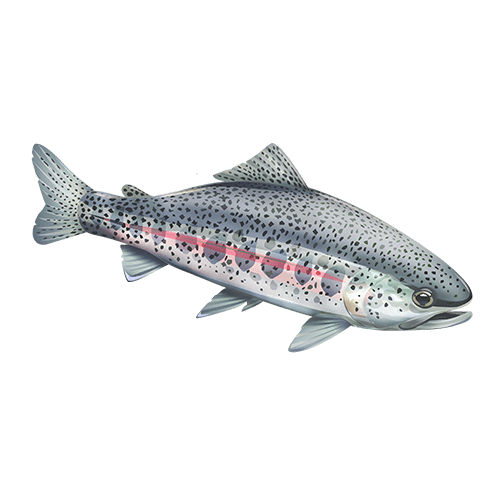Table of Contents
Rainbow Trout Farming For Business
Aquaculture, especially fish culture (farming), is increasing; henceforward, commercial finfish culture in fresh and brackish water is now common to leading in most African countries.
The major criteria in selecting fish species suitable for commercial-scale, inland saline aquaculture are essentially the same for any aquaculture industry.
The selected species must be robust, have a rapid rate of growth, well established hatchery techniques and good market acceptance.
Rainbow trout appear to be well adapted fish to rapid changes in salinity and is often directly transferred from fresh to oceanic waters in aquaculture grow-out situations. It has been reported that rainbow trout weighing 40-120 grams can tolerate direct transfer from fresh water to saline water without any visible signs of stress.
Fish Habitat Adaptability
Rainbow trout can easily adapt to various aquatic habitats and environments. They prefer cool freshwater streams with gravel bottoms and natural cover like downed trees and boulders.
Rainbow trout can be raised in net cages and fencing off in swamps and lakes; tanks and ponds.
Fish farmed in ponds offer different advantages are;
Suitable for small-scale farmers especially in regions where water is available in sufficient quantities.
Fish can be fed with on-farm products.
Water from ponds and ponds sediments are rich in nitrogen and phosphorus which can be used for irrigation and fertilizing crop gardens.
Due to the nature of the aquaculture setting and the importance of product quality, the behaviour and needs of rainbow trout in the brackish water environment and optimization methods to increase production in unit area is necessary to understand constructing an appropriate trout inland brackish water aquaculture.
Hazards And Challenges In Fish Farming For Business
Sources, frequencies, qualities and quantities of water available.
Difficulty in sourcing for healthy and quality fingerlings or juvenile seeds.
No organized marketing platform.
Inability to process fish for wider market consumption.
To date, funding for farmers has remained a night mare.
A major challenge that scares fish farmers is problems associated with farming labourers.
Finally, poaching and direct stealing of fish from the ponds are still going on unabated.
Rainbow Trout Breeds Appearance
Brown trout or sea trout have black, red and orange spots. They are native in the United Kingdom.
Rainbow trout and cutthroat trout depict similar appearance and they are closely related; also share similar habitat requirements; spawning at around the same time. Rainbow trout only have black spots.
Trout Pond Management
Trout stocking in waters that are warmer than 20 degrees Celsius (68 degrees Fahrenheit) is not recommended especially smaller sized fish, so early fall is the best time to stock.
When receiving fingerlings are received in plastics or containers in your water, they are to temper within 6 degrees Celsius before releasing fish onto the pond.
Naturally fertile and waterweed growth ponds are likely to produce about 22.7 – 45.4 kg (50 – 100 pounds) of trout per surface acre of water. pond water varies in productivity as some aqua farmers record the rate of growth, number of fish, and the weight of fish removed by fishing.
Fed-ponds have a much higher rate of production therefore stocking rates are possible with regular daily feeding. How To Raise Rainbow Trout A properly fed pond can produce 453.6 – 9,072 kg (1,000 – 2,000 pounds) of fish per acre. In this way, the production in fishing is profitable, best utilize the water resource and it may be a practical way to prevent and control submersed waterweeds.

Growth Rate And Period For Growing
Trout are expected to grow about 2.5 cm (1 inch) per month during spring and summer growing season in natural waters. Though some advanced fry which are 2.5 – 5 cm long (1 – 2 inches) bought cheaper have a mortality rate of 30-50 percent while fingerlings about 5 – 10 cm long (2 – 4 inches) have low mortality rate.
Fishing Process
Methods Of Feeding Fish
Trout can be fed manually or mechanically by;
Broadcasting feed
Demand feeder
Automatic feeder
Fish Health Disease And Predators Management
Fish diseases are caused by fish parasites and overcrowding of fish in ponds encourages diseases.
Poor water quality will result in death of fish.
Starved fish are highly prone to disease attacks.
Over fertilization of pond water will lead to high density algal bloom that can reduce the amount of dissolved oxygen.
Common fish predators should be prevented from causing fish losses in ponds which include water snakes, turtles, frogs, water birds, crocodiles, crabs, etc.
Ensure regular cleaning of pond site because predators hide in bushes.
Hunt predators by using traps or point blank killings.
It is wise to fence the pond.
Fish Farm Record Keeping
It is important to keep records of every activity regarding aqua farming which will make it helpful for farmer to evaluate profitability and general economic of fish farm investment. This will also help in vital management information for future planning, improvement and development of the farm. Records also provide necessary ground to obtain financial assistance.
MARKETING
Fish farmers who are ready to harvest their first crop of fish should know the following;
• Where to sell your produce whereby in some cases you find that the fish are sold at the fish farms.
• Target market for your produce.
• Sourcing a wholesaler for your produce and when to deliver.
• The criteria used for evaluation of produce.
• The price to pay and the retained amount will be determined in which way.
• Avoiding certain failures on aquaculture produce based on the initial market place for producers.
• Meeting the potential demand for consumers.
• Knowing whether to supply filleted fish frozen or fresh; selling fish as a whole frozen or fresh.
• Prices should be reasonable to cover costs for farming.

